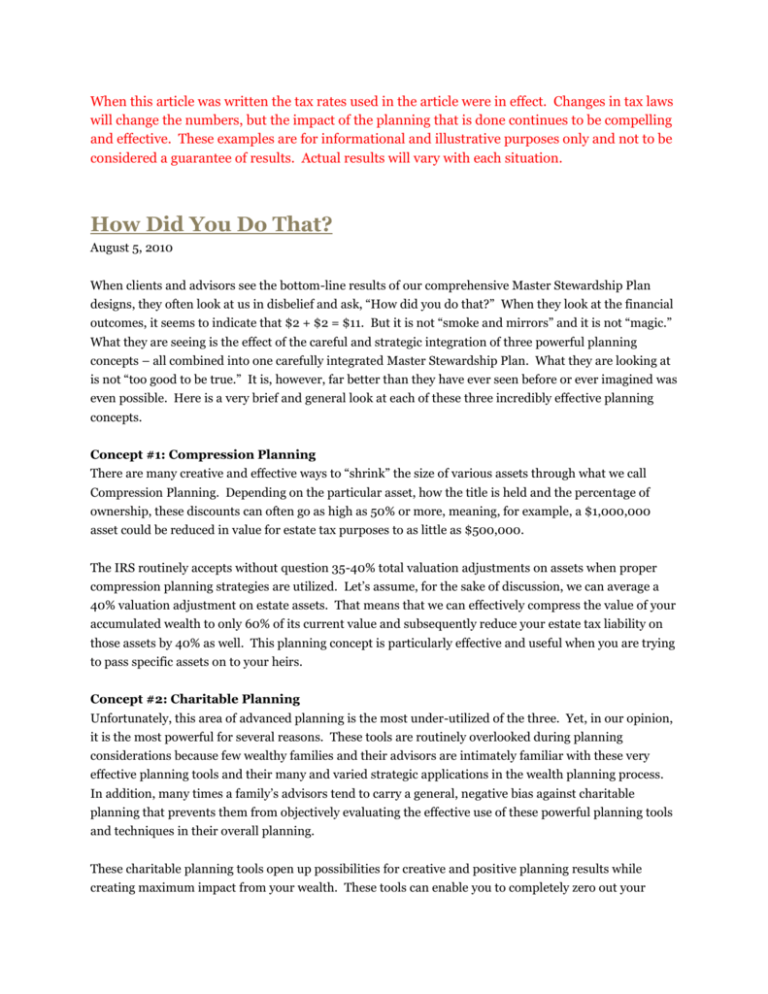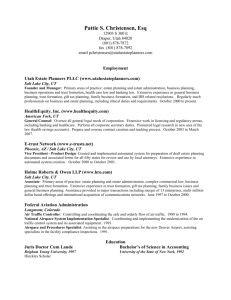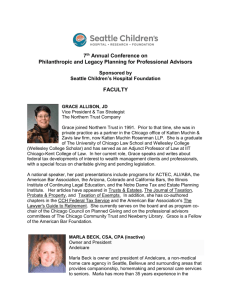
When this article was written the tax rates used in the article were in effect. Changes in tax laws
will change the numbers, but the impact of the planning that is done continues to be compelling
and effective. These examples are for informational and illustrative purposes only and not to be
considered a guarantee of results. Actual results will vary with each situation.
How Did You Do That?
August 5, 2010
When clients and advisors see the bottom-line results of our comprehensive Master Stewardship Plan
designs, they often look at us in disbelief and ask, “How did you do that?” When they look at the financial
outcomes, it seems to indicate that $2 + $2 = $11. But it is not “smoke and mirrors” and it is not “magic.”
What they are seeing is the effect of the careful and strategic integration of three powerful planning
concepts – all combined into one carefully integrated Master Stewardship Plan. What they are looking at
is not “too good to be true.” It is, however, far better than they have ever seen before or ever imagined was
even possible. Here is a very brief and general look at each of these three incredibly effective planning
concepts.
Concept #1: Compression Planning
There are many creative and effective ways to “shrink” the size of various assets through what we call
Compression Planning. Depending on the particular asset, how the title is held and the percentage of
ownership, these discounts can often go as high as 50% or more, meaning, for example, a $1,000,000
asset could be reduced in value for estate tax purposes to as little as $500,000.
The IRS routinely accepts without question 35-40% total valuation adjustments on assets when proper
compression planning strategies are utilized. Let’s assume, for the sake of discussion, we can average a
40% valuation adjustment on estate assets. That means that we can effectively compress the value of your
accumulated wealth to only 60% of its current value and subsequently reduce your estate tax liability on
those assets by 40% as well. This planning concept is particularly effective and useful when you are trying
to pass specific assets on to your heirs.
Concept #2: Charitable Planning
Unfortunately, this area of advanced planning is the most under-utilized of the three. Yet, in our opinion,
it is the most powerful for several reasons. These tools are routinely overlooked during planning
considerations because few wealthy families and their advisors are intimately familiar with these very
effective planning tools and their many and varied strategic applications in the wealth planning process.
In addition, many times a family’s advisors tend to carry a general, negative bias against charitable
planning that prevents them from objectively evaluating the effective use of these powerful planning tools
and techniques in their overall planning.
These charitable planning tools open up possibilities for creative and positive planning results while
creating maximum impact from your wealth. These tools can enable you to completely zero out your
estate taxes, eliminate all future capital gains taxes and even substantially reduce current income taxes
year after year for charitable giving that may often not even happen until after your death.
These tools allow you to divert millions of dollars to ministries that would otherwise end up going to the
IRS in various taxes both during your lifetime and at death. Utilizing these tools will enable you to selfdirect these millions of tax dollars to the ministries that you personally care about without reducing or
eliminating your children’s inheritance. These are the tools that make the estate planning process
fun, exciting and fulfilling. Any wealth plan that doesn’t use one or more of these planning tools simply
will not be as financially effective or as personally rewarding as it could be.
Concept #3: Leverage Planning
There are a number of techniques and strategies that can be used to leverage your wealth producing
substantially greater planning results when they are effectively incorporated into the Master Stewardship
Planning process. Unfortunately, we have found, as with the charitable planning concepts, that quite
often both the affluent family and their advisors often have major misunderstandings of the proper and
various leveraging techniques and tools and, consequently, carry a strong but unnecessary negative bias
against them. As a result, they often avoid them altogether which greatly diminishes the overall effective
leverage of the family’s financial capacity.
Let me give you one example. Consider the idea of incorporating life insurance into an overall, master
plan. This suggestion often creates a negative reaction to some extent from some family member or one of
their advisors – primarily due to one or more misunderstandings of the appropriate purpose and use of
insurance products in strategic planning.
Let me give you two common scenarios with wealthy families. First, a wealthy businessman wholly rejects
the need for any life insurance in any amount because he is now independently wealthy. Why would he
need insurance now? He is worth millions. His wife and children (who are usually already grown and
gone from home) will be more than adequately cared for in the event of his death. When he was younger
and poorer, insurance made sense to take care of them, but not now. In this scenario, this man is clearly
correct in his assessment that he no longer needs life insurance to protect his wife and family. For this
reason, he is absolutely correct. He no longer needs life insurance. And since he no longer needs it for
this specific reason, he mistakenly concludes that he no longer has any need or use for it for any reason.
In a second scenario, and one to the other extreme, we find many wealthy people have been effectively
persuaded by one or more of their advisors that they should acquire a multimillion dollar life insurance
policy in order to “discount” the cost of the estate taxes. (The premiums on the insurance contract are
indeed much cheaper than the estate taxes due.) This is a very common and very traditional approach to
estate planning. The acquisition of life insurance for this purpose does, indeed, effectively leverage the
person’s wealth by using “discounted dollars” to pay the onerous estate tax burden their estate will bear.
Unfortunately, they have not solved the estate tax problem with this strategy, they have simply figured out
a way to reduce the cost of paying the tax bill. We, on the other hand, design our Master Stewardship
Plans to eliminate the estate taxes altogether, subsequently eliminating the need for life insurance to pay
estate taxes.
The elimination of the estate taxes liability through strategic Master Stewardship Planning allows the
family to now be extremely creative with the leveraged use of life insurance in the overall planning
process. Now, when it is appropriate, maximum planning leverage can be achieved through the proper
and creative uses of life insurance.
Combining the Three Concepts
Each one of these three planning concepts by itself is extremely powerful and effective. But when any two
of these three techniques is utilized in tandem, there is an exponential increase in their combined
effectiveness. And when you can creatively combine all three of these powerful planning concepts into
one comprehensive plan, which is our planning objective, the bottom line results are often absolutely
beyond belief.
The most effective Master Stewardship Plan will utilize and integrate all three of these planning concepts
together in any number of possible planning combinations, producing the best possible bottom-line
results for our families. It is our intimate familiarity and regular use of these three concepts’ various
planning tools and their dozens of subtle variations that makes the plans we design for the families we
serve so effective.
“How did you do that?” The answer is really quite simple. We do it by taking a comprehensive planning
approach, utilizing all three of these powerful planning concepts to develop an overall Master Stewardship
Plan.
© 2010 Stewardship Ministries | All Rights Reserved.










